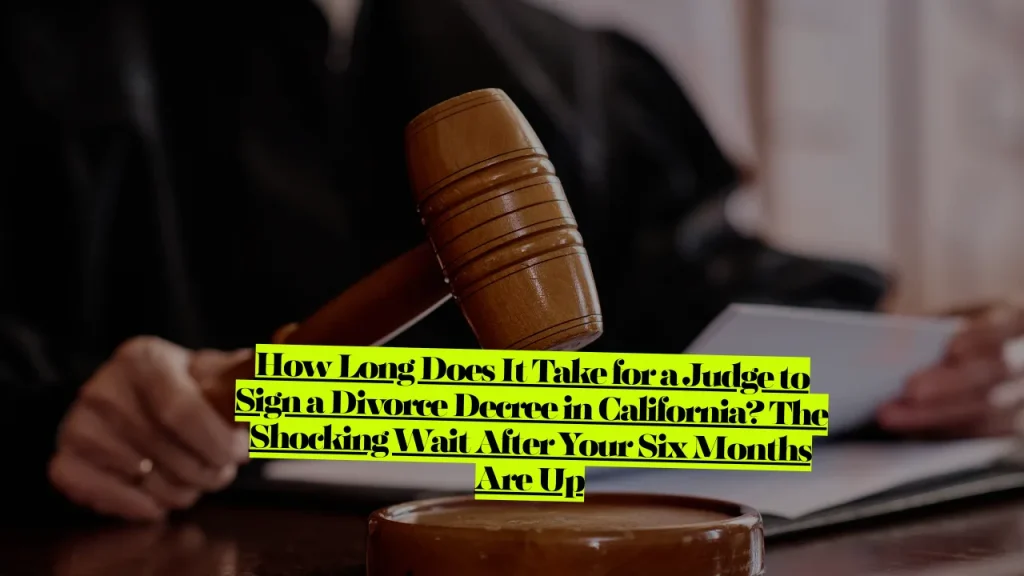How Long Does It Take for a Judge to Sign a Divorce Decree in California? The Shocking Wait After Your Six Months Are Up
After submitting your final judgment paperwork to a California court, expect to wait anywhere from one week to several months for a judge to sign your divorce decree. Most uncontested divorces see judicial approval within a few weeks after the mandatory six-month waiting period expires, but contested cases, court backlogs, and paperwork errors can push timelines to 90 days or longer.
California requires a minimum six-month waiting period from the date of service before any divorce can be finalized—but that’s just the beginning. The judge’s signature comes after this waiting period, and court processing delays mean you’re technically still married until that decree is signed and filed.
California’s Mandatory Six-Month Waiting Period Explained
California Family Code Section 2339(a) specifically provides that no judgment of dissolution is final for the purpose of terminating the marriage relationship until six months have expired from the date of service of the divorce papers. Most couples in California can be divorced in 6 months plus one day, but it all comes down to the date of service.
The six-month waiting period begins counting from the date the respondent was served with divorce papers or the date the respondent appeared in the case, whichever occurs first. Filing alone doesn’t start the clock—service must occur.
California’s Family Code section 2339(a) clarifies that the six-month waiting period can be lengthened by the court for good cause but makes no provision for it to be shortened. The courts use this period as a cooling-off period to allow parties to stop the divorce process and reconcile, should they so choose.
What Happens After the Six-Month Waiting Period
The six-month mark doesn’t automatically trigger divorce finalization. The marriage does not end automatically at the end of six months: One of the spouses or partners has to prepare the judgment form, with appropriate attachments, and have it signed by a judge.
You must submit a complete judgment packet including the Judgment of Dissolution (FL-180), along with attachments detailing custody, support, and property division, plus proof of service and disclosure declarations.
The clerk will process your paperwork and give it to a judge to review. This may take a week or even months. Ask the clerk what the usual time is to process.

Typical Timeline for Judge to Sign California Divorce Decree
In simple cases, signing the final divorce decree may take only a few days to a few weeks. But in more complex or high-volume jurisdictions, the wait can stretch to several months.
Uncontested Divorce: When both parties agree on all terms and the paperwork is complete, the judge can often sign the decree within 1 to 2 weeks. Some jurisdictions process these faster with electronic filing systems.
Contested Divorce: In cases involving disputes over custody, property, or spousal support, it may take several months from the final court appearance to obtain a signed decree due to hearings, motions, and document reviews.
Default Judgment: If you filed a Petition for Dissolution and served it and that’s all you did, then nothing else is going to happen. You will not get divorced. Nothing happens automatically. You must prepare and submit a proposed judgment even in default cases.
County Variations: Santa Clara Superior Court’s approval process for uncontested divorce judgments is currently experiencing significant delays, with recent cases taking approximately three and a half months for approval. Processing times vary dramatically by county based on caseload and staffing.
Major Factors That Delay Decree Signing
California’s court system handles a significant number of divorce cases. Depending on where you file, your local court may have a backlog of cases waiting to be reviewed. A high volume of cases can slow down the timeline for your judge to review and sign the paperwork.
Court Backlogs: Backlogged courts in busy jurisdictions can stretch even simple divorce cases, with processing times extending 30 to 90 days or more due to high caseloads and limited judicial resources.
Paperwork Errors: Mistakes on the paperwork are surprisingly common. Whether it’s missing signatures, incorrect forms, or other errors, even a small oversight can cause a delay. In these cases, the court will send the forms back for correction, which can push your timeline back by weeks or even months.
Case Complexity: If your divorce involves high-value assets, detailed custody arrangements, or any other complexities, it’s likely that the judge will take extra time to review everything before finalizing the decree.
Incomplete Documentation: If something is missing or wrong, you will get the forms back, not signed or stamped, with information about what’s missing.
Judicial Caseload: Each court has a different caseload, and every judge has a unique schedule, so it is difficult to determine exactly how long it will take.
Understanding the FL-180 Judgment Form
The FL-180 Judgment form contains the first pages of the final orders for your divorce, legal separation, or annulment case, specifying the date on which the judgment becomes finally effective for terminating the marriage relationship.
The FL-180 is California’s official divorce decree once signed by a judge and legally ends your marriage and enforces all court orders. This form is the “divorce decree” and will include the divorce date, six months from the date of service, and a name change if requested by one or both of the parties.
The termination date is six months after the petition for divorce papers were served, or six months after your spouse responded to the papers.
Complete the FL-180 form accurately, attach all supporting documents including agreements and court orders related to child custody, support, and property division, file with the Superior Court, and ensure copies are served to the other party.
Contested vs. Uncontested Divorce Processing Times
Uncontested Divorce: An uncontested divorce, where both spouses agree on all major issues—like property division and child custody—tends to move faster. In these cases, the judge can sign off relatively quickly after six months.
If you are proceeding with an uncontested divorce, you’ll just have to sit tight until California’s minimum waiting period has expired. A judge can’t sign off on your divorce until at least six months after the papers have been served. When six months have gone by, the judge will sign a judgment granting you a divorce.
Contested Divorce: A contested divorce, where disputes arise over any major topics, often takes much longer. Additional hearings, negotiations, and even mediation can push back the final decree.
Contested divorces often involve more complexities, such as disputes over child custody, property division, or alimony. In these cases, even after a judge renders a decision, additional time may be needed to review, revise, or complete the necessary documents to meet legal standards.
What Happens Immediately After the Judge Signs
If everything required is there, a judge will sign your judgment. The clerk will stamp the Judgment and the Notice of Entry of Judgment “filed.”
When you receive the Notice of Entry of Judgment marked “filed,” your case is complete. If you asked for a divorce (dissolution), the Notice will say the date your marriage or domestic partnership officially ends.
A court clerk will mail the divorce judgment to each spouse or partner, with the date that the judgment was filed stamped in the upper right corner. The court will mail copies to you and your spouse using the envelopes you provided when filing.
A case is not final until a judge signs the Judgment and files a Notice of Entry of Judgment (form FL-190). You are not officially divorced until this occurs.
Once the divorce is final, you and your spouse will have to work to comply with the terms in the decree. This might involve dividing and allocating marital assets, assuming property and debt, transferring title to property from one spouse to another, and closing joint financial accounts.
How to Get Certified Copies of Your Divorce Decree
The most efficient way to obtain a copy of your divorce decree is to contact the California County Superior Court in which your divorce was granted. The clerk of court or records office at that location should be able to issue you a certified copy of your entire divorce decree and any related documents.
The FL-190 is just telling you that your divorce was entered into the official records. The form that you want is an FL-180: Judgment. You’ll have to go to court and pull the file, then ask the clerk to make you a certified copy. It’ll cost between $15 and $25, depending upon the number of pages.
Fees for these documents can vary. In Santa Clara, for example, you’ll pay between $15 and $40 for certification, depending on the type of divorce, and $15 for research if you don’t know the case number.
Expediting the Decree Signing Process
The more issues you and your spouse can agree on before the final decree, the quicker the process can move. Working together to settle things like property division, child custody, and spousal support can significantly cut down the time it takes for the judge to finalize everything.
Double-Check All Paperwork: Before submitting your forms, make sure everything is accurate and complete. Double-check signatures, form numbers, and other small details. This simple step can prevent delays caused by the court requesting corrections.
Work with an Attorney: An experienced family law attorney can help anticipate potential delays and guide you through the paperwork and court procedures. They’ll ensure everything is submitted correctly and keep the process moving smoothly.
One-Day Divorce Programs: Through the One Day Divorce Program in California available in certain counties, you can request an appointment with your county court and ask a judge to review your divorce settlement. If everything is fair and legal, the judge will sign the decree, ultimately making it final as soon as the six-month waiting period is over.
Private Judge Option: If you choose to hire a private judge, your judge will be able to review and sign off on your judgment much faster than a public judge.
Common Reasons Judges Delay or Return Decrees
Missing Required Attachments: Many divorces will need several additional documents attached to the FL-180 form, including child custody orders (FL-341), child support orders (FL-342), spousal support orders (FL-343), and property division orders (FL-345).
Incomplete Disclosure Declarations: You need declarations confirming both parties completed their Preliminary Declaration of Disclosure and Income and Expense Declarations (FL-141 and FL-150).
Incorrect Termination Date: The termination date on the FL-180 must be calculated as six months plus one day from the date the petition was served on the respondent.
Missing Envelopes: You need two addressed, stamped envelopes with the Court’s return address—one will have your address; the other will have your spouse’s address.
Local Court Form Requirements: Some cities or counties in California have their own forms that need to accompany a divorce judgment form beyond the state FL-180.
What to Do While Waiting for the Judge’s Signature
This waiting period can be extremely frustrating and stressful, since there is little you can do to speed up the process without hiring a private judge.
Parties should check with the court clerk for status updates and confirm if any further documents or hearings are needed. Keep copies of all filings and communications to track progress.
You will first and foremost want to review your judgment to make sure you are in full compliance with the orders. It’s easy to forget some of the steps you need to take, especially when it’s been months since you originally submitted your judgment to the court.
You may need to take care of a few basic things after you get divorced, like change your insurance policies or will. Prepare for these transitions even before the decree is officially signed.
California Family Code Sections Governing Divorce Timelines
California Family Code Section 2339(a) establishes the mandatory six-month waiting period before a judgment of dissolution becomes final.
Family Code section 2339(b) states that the court may extend the six-month period for good cause shown.
Family Code 2340 states that a judgment of dissolution of marriage shall specify the date on which the judgment becomes finally effective for the purpose of terminating the marriage relationship of the parties.
Family Code section 2343 provides that the court may, upon notice and for good cause shown, retain jurisdiction over the date of termination of the marital status, or may order that the marital status be terminated at a future specified date.
Key Difference: Divorce Judgment vs. Divorce Decree in California
In California, the court uses form FL-180 “Judgment” to grant a divorce. The court mails this completed, stamped form to each spouse along with a completed form FL-190 “Notice of Entry of Judgment.”
When your agreement is filed, it becomes a final court order called a Judgment for Dissolution of Marriage FL-180, sometimes referred to as a divorce judgment or divorce decree.
A divorce decree is a legally binding document issued by the court that formally ends a marriage, containing all of the information available regarding a divorce case, including orders or agreements regarding custody, support, and property division.
California also issues a divorce certificate for record-keeping purposes through the Department of Public Health for divorces between 1962 and June 1984. A divorce certificate includes the parties’ names along with the date and place of the divorce but does not include personal details, agreements, or orders of the court.
Bifurcation: Terminating Marital Status Before Final Resolution
Since the 6 month cooling off period only applies to termination of the marital relationship, after 6 months have passed, either spouse can request to bifurcate (separate) and terminate marital status. This means either party can ask the court to terminate the marital status in their case, even if there are other issues in the case that remain unresolved (i.e. support, property division, etc.). Upon termination of marital status, both parties are free to remarry.
The judgment that ends the marriage’s status does not have to also resolve all the other divorce issues. Marital status can end before all the assets, debts, support and/or custody issues are finalized under certain circumstances.
FAQ: California Divorce Decree Timeline
How long after filing for divorce can it be finalized in California?
California requires a six-month waiting period after filing and serving the divorce papers. The divorce becomes final six months and one day from the filing date, assuming all paperwork is properly submitted and approved by a judge.
Can the six-month waiting period be waived in California?
There is no exception to the “cooling-off” period. Thus, six months is the earliest a court can enter a judgment for dissolution of marriage, and even if the parties settle all issues in their case, they must still wait six months before their marriage will be legally ended.
Am I legally divorced before the judge signs the decree?
No. You are not officially divorced until the judge signs the final decree and it’s entered into the court record, making the separation legally binding.
What happens if I need to change the decree after it’s signed?
Even though a divorce decree is final, the terms of a divorce can be changed. Either spouse can request to modify an order if things change in the future.
Can I remarry during the six-month waiting period?
The 6-month waiting period (plus one day) is the earliest date the couple can be considered legally divorced. This is also the earliest either spouse can remarry.
What if we reconcile after filing for divorce?
If parties decide to reconcile within the six month waiting period, they can file paperwork with the court to dismiss their divorce case. Furthermore, even if the court has already entered a final judgment and established a marriage termination date, filing a dismissal extinguishes the pending termination—but only if the termination date has not yet passed.
Do both spouses need to sign the divorce judgment?
In uncontested cases, both parties typically sign a stipulation or marital settlement agreement that gets attached to the FL-180 Judgment form. In default or contested cases decided by the court, only the judge’s signature is required to finalize the decree.
Disclaimer: This article provides legal information about California divorce decree signing timelines based on California Family Code, court procedures, and verified legal resources current as of the publication date. It is for educational purposes only and does not constitute legal advice. Timelines and procedures may vary by county and individual case circumstances. For specific legal advice regarding your divorce case or timeline questions, please consult with a qualified California family law attorney. Always verify current procedures and timelines through official California court resources and your local court clerk’s office.
Internal Links:
- Capital One $425 Million Settlement
- Can You Sue for Identity Theft?
- What Is Misdemeanor Identity Theft?
About the Author

Sarah Klein, JD, is a former family law attorney with over a decade of courtroom and mediation experience. She has represented clients in divorce, custody cases, adoption, Alimony, and domestic violence cases across multiple U.S. jurisdictions.
At All About Lawyer, Sarah now uses her deep legal background to create easy-to-understand guides that help families navigate the legal system with clarity and confidence.
Every article is based on her real-world legal experience and reviewed to reflect current laws.
Read more about Sarah
